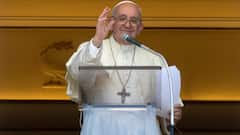Flashback 1961: When Russia Tested Tsar Bomba, World’s Most Powerful Nuclear Weapon
Soviet Union detonated Tsar Bomba, Russian for 'King of Bombs', in a test over Novaya Zemlya island in Arctic Ocean on October 30, 1961. It produced most powerful human-made explosion ever recorded.

On this day 61 years ago, the erstwhile Soviet Union detonated a thermonuclear bomb in a test over Novaya Zemlya island in the Arctic Ocean. Coming 16 years after the dreaded Hiroshima and Nagasaki nuclear attacks, the test of the world’s most powerful nuclear weapon had left everyone shocked. Called Tsar Bomba, Russian for ‘King of Bombs’, it was said to come with a force 3,333 times that of the bomb dropped on Hiroshima by the United States during World War II.
Here is a look back at the October 30 event of 1961, which saw the largest nuclear weapon ever being set off, producing the “most powerful human-made explosion ever recorded”, according to Britannica.
Tsar Bomba, The ‘King Of Bombs’
Tsar Bomba, officially known as RDS-220 and also called Big Ivan, was built in 1961 by a group of Soviet physicists, at a time when the Cold War between the US and the USSR had grown quite tense. Britannica notes that the “three-stage bomb” was meant to be a show of Soviet strength.
The weapon with a 100 mega tonne capacity, unparalleled in power, was modified to yield 50 mega tonnes because the fallout from such a blast was considered too dangerous for a test situation. At 50 mega tonnes, the weapon was estimated to be about 3,800 times the strength of the bomb the US bomb used on Hiroshima on August 6, 1945, the Britannica article says, adding that the fusion process of the device was also altered to lessen the fallout. The weapon that was finally tested weighed 27 tonnes, and had a length of some 26 feet and a diameter of about 7 feet.
The device was carried by a modified Tu-95V bomber, equipped with a special parachute to slow its fall, which allowed the aircraft to fly a safe distance away from the blast site.
What Happened On October 30, 1961?
Piloted by Andrey Durnovtsev, the Tu-95V aircraft took off from Kola Peninsula on October 30, 1961, and was joined by an observer plane, according to Britannica records. It dropped the Tsar Bomba over the Mityushikha Bay test site at approximately 11:32 AM Moscow time on the deserted Novaya Zemlya island.
The bomb was 4 km above the ground when it exploded, producing a more than 60-km-high mushroom cloud (see photo above), the Britannica article notes, adding that the flash was seen some 1,000 km away.
“The clouds beneath the aircraft and in the distance were lit up by the powerful flash,” a BBC report quoted a Soviet cameraman who witnessed the detonation as saying. “The sea of light spread under the hatch and even clouds began to glow and became transparent. At that moment, our aircraft emerged from between two cloud layers and down below in the gap a huge bright orange ball was emerging.”
He added: “The ball was powerful and arrogant like Jupiter. Slowly and silently it crept upwards... Having broken through the thick layer of clouds it kept growing. It seemed to suck the whole Earth into it. The spectacle was fantastic, unreal, supernatural.”
Before Tsar Bomba, the largest explosion ever conducted was by the US — a 15-mega-tonne ‘Castle Bravo’ hydrogen bomb detonated on Bikini Atoll in 1954.
The classified footage of the world’s largest nuclear explosion was released by Russia in 2020. The footage showed an immense fireball and the 60-km high mushroom cloud lighting up the sky, media reports from the time said, adding that the views were captured by cameras installed on the ground and also on board two Soviet aircraft.
The footage was released as part of a documentary published online for the first time by Russian state nuclear agency Rosatom as the country organised events to mark the 75th anniversary of Russia’s atomic industry.
“The testing of an exceptionally powerful hydrogen load ... confirmed that the Soviet Union is in possession of a thermo-nuclear weapon with power of 50 megatons, 100 megatons and more,” a Reuters report from August 2020 quoted a narrator as telling the audience.
The 30-minute film featured all stages of the test — from transportation of the weapon by railway in an aviation bomb casing, to measurements of the radioactive fallout after the explosion, the report noted.

The Tsar Bomba Aftermath
The damage was massive. The explosion levelled an uninhabited village, Severny, located 55 km from ground zero, and reached buildings more than 160 km away, according to available records. It was also estimated that heat from the blast could have caused third-degree burns up to 100 km away.
According to the BBC report cited above, the explosion unleashed unbelievable energy — “now widely agreed to be in the order of 57 megatons, or 57 million tons of TNT”. Sensors registered the blast wave orbiting the Earth three times, it said. However, the report added, the amount of radiation was surprisingly low because the fireball had not made contact with the ground.
The test did not remain a secret. According to the BBC report, the US had a spyplane flying only tens of kilometres away from the blast site. Codenamed Speedlight, the aircraft carried a special optical device called bhangmeter, which calculated the yield of far-off nuclear explosions.
The USSR had to face international condemnation after the test.
The group of Soviet physicists that built the bomb included Andrey Sakharov, a Soviet atomic bomb programme veteran from the beginning who had been part of the USSR team that built some of its earliest atom bombs. The unbelievable and formidable power of the Tsar Bomba created by him persuaded him to later famously renounce nuclear weapons.
Trending News
Top Headlines








































